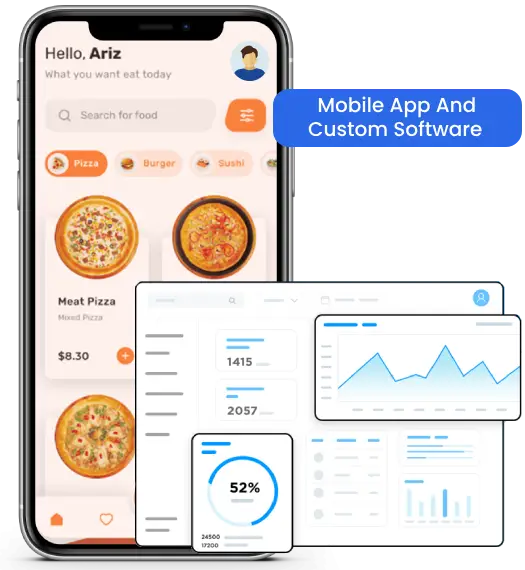The business world is on its way to rapidly transforming from traditional brick-and-mortar outlets to the online world. The swift change is caused by the convenience of accessing the business information on the go and reduced the latency involved in the process. A digital platform backed with essential functionality provides complete access to streamline business operations and efficiently manage it. In this informative blog, we will deeply dive into the building of the digital business technology platform and share our opinion on how you can get started with it and benefit from it. Stride along till the end to know everything associated with a digital business technology platform.
What is a Digital Business Technology Platform?
A digital business technology platform (DBTP) acts as the nervous system of a modern enterprise. It’s a comprehensive suite of technologies that work together to enable and orchestrate digital business capabilities.
Examples of Digital Business Technology Platforms
- Salesforce: Provides a cloud-based platform for customer relationship management (CRM), marketing automation, and analytics.
- Microsoft Azure: Offers a comprehensive suite of cloud computing services for building, deploying, and managing business applications.
- Amazon Web Services (AWS: Another leading cloud platform offering a wide range of on-demand computing services for businesses.
What is the Need for a Digital Business Technology Platform?
In today’s digital landscape, businesses face constant pressure to adapt, innovate, and deliver exceptional customer experiences. This is where digital business technology platforms come in. DBTPs are becoming increasingly essential for businesses because of the following reasons.
Addressing Challenges of Traditional IT Systems
- Data Silos: Traditional IT systems often operate in isolation, creating data silos where information gets trapped within individual departments. This fragmented approach hinders data-driven decision making and creates a limited view of the customer journey.
- Lack of Agility: Legacy systems can be inflexible and slow to adapt to changing market conditions or new business needs. This can lead to missed opportunities and hinder a company’s ability to compete effectively.
- Manual Processes: Many businesses rely on manual workflows that are inefficient and prone to errors. This wastes valuable time and resources that could be better spent on strategic initiatives.
- Limited Innovation: Traditional IT infrastructure often struggles to support the development and deployment of innovative new digital products and services.
How DBTPs Bridge the Gap?
- Unified Platform: A digital business technology platform acts as a central hub that integrates various existing systems and applications, fostering data exchange and breaking down data silos. This provides a holistic view of the organization and empowers data-driven decision making.
- Enhanced Agility: The platform’s open architecture and scalability enable businesses to adapt to changing market dynamics and customer needs more quickly. New applications and functionalities can be integrated or developed faster to meet evolving requirements.
- Process Automation: Digital business technology platforms automate manual tasks and workflows across departments, streamlining operations, reducing errors, and freeing up employees to focus on higher-value activities.
- Data-Driven Culture: By providing tools for data management, analysis, and visualization, DBTPs foster a data-driven culture within the organization. Businesses can leverage data insights for informed decision-making, risk management, and deeper customer understanding.
What Are the Advantages of Digital Business Technology Platforms?
Digital business technology platforms offer a multitude of advantages that can significantly transform how businesses operate and compete in the digital age. Let us take a closer look at some of the key benefits:
Enhanced Efficiency and Productivity
- Automation: Digital business technology platforms automate manual tasks and workflows across departments, freeing up employee time for more strategic work. This streamlines operations, reduces errors, and improves overall productivity.
- Data-Driven Decision Making: The platform provides real-time access to data and analytics, allowing businesses to make data-driven decisions that optimize processes, resource allocation, and marketing campaigns.
- Improved Collaboration: By integrating various systems and applications, DBTPs facilitate seamless communication and collaboration between departments, fostering a more unified and efficient work environment.
Increased Agility and Innovation
- Faster Development Cycles: The platform provides best technology for ecommerce website or customizing internal applications to meet specific business needs. This allows for faster development cycles and quicker time-to-market for new products and services.
- Open Architecture: Digital business technology platforms are built on open standards and APIs, making it easier to integrate with existing systems and future technologies. This fosters flexibility and adaptability to changing market demands and emerging trends.
- Innovation Catalyst: The platform empowers businesses to experiment and develop innovative digital solutions by providing a foundation for building new applications and leveraging data-driven insights.
Improved Customer Experience
- Unified Customer View: Digital business technology platforms consolidate customer data from various touchpoints, providing a holistic view of customer behavior and preferences. This enables businesses to personalize the customer experience and deliver a more consistent journey across channels.
- Real-Time Visibility: The platform provides real-time insights into customer interactions and service requests. Businesses can respond promptly to customer inquiries and resolve issues efficiently, leading to higher customer satisfaction.
- Omnichannel Engagement: DBTPs facilitate the integration of various customer touchpoints, enabling businesses to deliver a seamless omnichannel experience across online, mobile, and physical channels.
7 Steps to Building a Digital Business Technology Platform
A well-designed DBTP can be a game-changer for your organization, but building one requires careful planning and execution. Here’s a breakdown of the 7 key steps involved:
Define Your Business Goals and Needs
- Strategic Alignment: Clearly define how the digital business technology platform aligns with your overall business goals and digital transformation strategy. What challenges are you trying to solve, and what opportunities do you want to unlock?
- Identify User Needs: Consider the needs of different user groups within your organization, such as sales, marketing, customer service, and operations. What functionalities will be most valuable for them?
- Prioritize Capabilities: Based on your goals and user needs, prioritize the essential functionalities you want your DBTP to deliver initially.
Assess Your Existing IT Landscape
- Inventory of Systems: Create a comprehensive inventory of all existing IT systems, applications, and data sources within your organization.
- Integration Potential: Evaluate the integration capabilities of your existing systems and how they can connect with the digital business technology platform. Identify any potential gaps or roadblocks.
- Data Quality Assessment: Analyze the quality of data within your existing systems. Ensure data is accurate, consistent, and readily available for migration and utilization within the DBTP.
Develop Your DBTP Architecture
- Open Standards and APIs: Choose an open architecture that leverages open standards and APIs to facilitate seamless integration with existing and future systems.
- Scalability and Security: Design the platform with scalability in mind to accommodate future growth and increasing data volumes. Prioritize robust security features to protect sensitive business data.
- Flexibility and Customization: Consider the need for customization to cater to specific departmental or user group needs while maintaining a unified platform core.
Select the Right Technologies
- Evaluate Vendor Solutions: Research and compare digital business technology platform solutions offered by different vendors. Consider factors like scalability, security features, integration capabilities, and ease of use.
- Cloud vs. On-Premises: Decide whether a cloud-based or on-premises deployment model best suits your needs. Cloud platforms often offer greater scalability and flexibility, while on-premises solutions may provide more control over data security.
- Open-Source Options: Explore open-source DBTP frameworks if your budget or technical expertise allows for customization and development.
Implement and Integrate the Platform
- Phased Approach: Consider implementing the digital business technology platform in phases, starting with core functionalities and gradually integrating additional features based on user feedback and evolving needs.
- Data Migration and Integration: Develop a plan for migrating data from existing systems to the digital business technology platform. Ensure data quality and consistency throughout the migration process.
- Change Management: Communicate effectively with employees about the DBTP implementation and provide training to ensure user adoption and maximize platform utilization.
Test, Monitor, and Refine
- Thorough Testing: Rigorously test the digital business technology platform functionalities, integration points, and user interface to ensure smooth operation and identify any potential issues before full-scale deployment.
- Performance Monitoring: Continuously monitor the performance of the DBTP and address any bottlenecks or performance issues promptly.
- Gather User Feedback: Actively seek feedback from users to identify areas for improvement and prioritize ongoing platform enhancements based on real-world experience.
Continuously Innovate and Adapt
- Stay Updated with Technology Trends: Keep up with the latest advancements in digital technologies and consider how they can be integrated with your digital business technology platforms to enhance its capabilities.
- Embrace Data-Driven Decision Making: Leverage data insights from the DBTP to inform future platform development, identify new business opportunities, and adapt to changing market dynamics.
- Maintain Security and Compliance: Continuously evaluate and update security measures to address evolving digital threats and ensure compliance with relevant data privacy regulations.
Wrapping Up
By following these steps and fostering a culture of continuous improvement, you can build a robust and scalable digital business technology platform that empowers your organization to thrive in the digital age. Remember, a successful DBTP journey requires a clear vision, collaboration across departments, and a commitment to ongoing innovation and adaptation. Leveraging the modern tech stack, Dreamer Technoland specializes in crafting personalized digital business technology platforms. If you are looking forward to one, let us help you!







